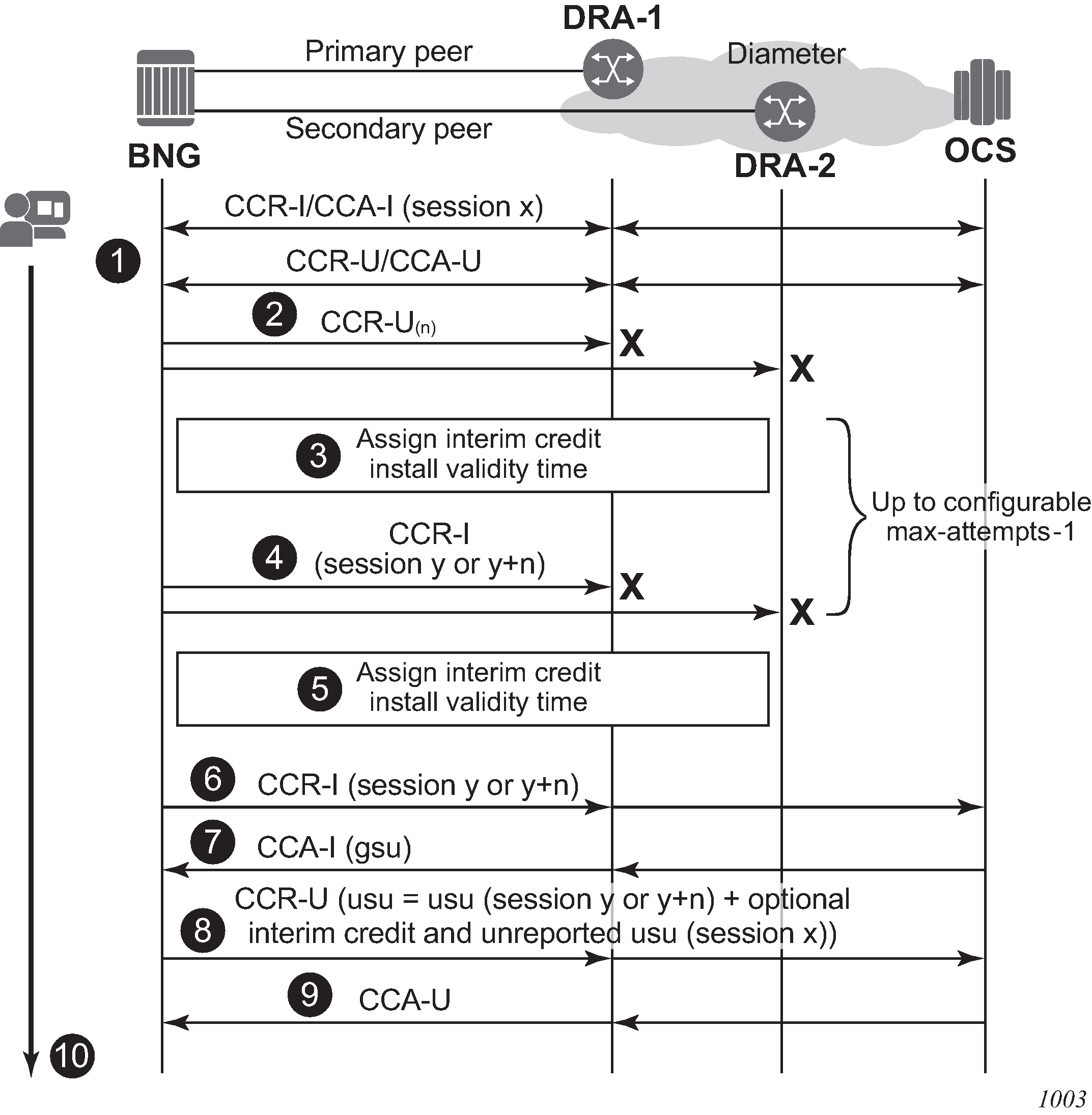
Figure: EFH - example call flow shows a sample call flow with EFH enabled. The following describes the call flow.
A Diameter Gy session is established between the Broadband Network Gateway (BNG), or credit control client, and the OCS, or credit control server.
A Credit Control Request Update (CCR-U) message is sent via the primary peer but no answer (CCA-U) is received. A timeout occurs which triggers a failover to the secondary peer. The same CCR-U is sent via the secondary peer. Again no answer is received. Because the CCFH value is set to CONTINUE for this session, EFH is activated.
The following EFH actions occur:
Service to the user continues uninterrupted.
If this is the first attempt to re-establish a Diameter Gy session:
The failed Diameter Gy session (session ID x) is terminated without sending a CCR-T (Terminate) message.
The unreported used credits for each rating group are stored in an EFH unreported credit counter.
A new Diameter Gy session (new session ID y) is created internally but is not yet established with the OCS; the CCR-I (Initial) message is sent later.
For all subsequent attempts to re-establish a Diameter Gy session:
The failed Diameter Gy session (session ID y or y+n) is terminated without sending a CCR-T (Terminate) message.
The unreported used interim credit for each rating group is added to the EFH unreported credit counter.
A new Diameter Gy session is created internally but not yet established with the OCS: the CCR-I (Initial) message is sent later. The internal Diameter session is created with the same session ID (y) or a new session ID (y+n) based on a configuration knob.
Pre-configured interim credit is assigned to all rating groups and an optional validity time is installed.
If either all interim credit is used or the validity time expires for one of the rating group, an attempt is made to establish the new Diameter Gy session (session ID y or y+n) with the OCS.
A CCR-I message is sent via the primary peer but no answer (CCA-I) is received. A timeout occurs which triggers a failover to the secondary peer. The same CCR-I is sent via the secondary peer. Again no answer is received.
EFH stays active for this user session.
Steps 3 and 4 can be repeated multiple times until the maximum number of interim credit allocations is reached and the user session is terminated (not shown in this example call flow).
The EFH actions are as follows:
Service to the user continues uninterrupted.
The failed Diameter Gy session (session ID y or y+n) is terminated without sending a CCR-T (Terminate) message.
The unreported used interim credit for each rating group is added to the EFH unreported credit counter.
A new Diameter Gy session is created internally but is not yet established with the OCS: the CCR-I (Initial) message is sent later. The Diameter session is created with the same session ID (y) or a new session ID (y+n) based on the configuration.
Pre-configured interim credits are assigned to all rating groups and an optional validity time is installed.
If either all interim credits are used or the validity time expires for one of the rating groups, an attempt is made to establish the new Diameter Gy session (session ID y or y+n) with the OCS.
A CCR-I message is sent via the primary peer.
An answer (CCA-I) is received with new granted service units (credit). Because communication with the OCS is restored, EFH becomes inactive.
The new Diameter Gy session resumes normal operation. Optionally, the EFH unreported credit usage is reported together with the usage from the newly granted credit in the next CCR-U credit negotiation for the rating group.
An answer (CCA-U) is received.
The service to the user continues and is uninterrupted during the OCS connectivity failure.